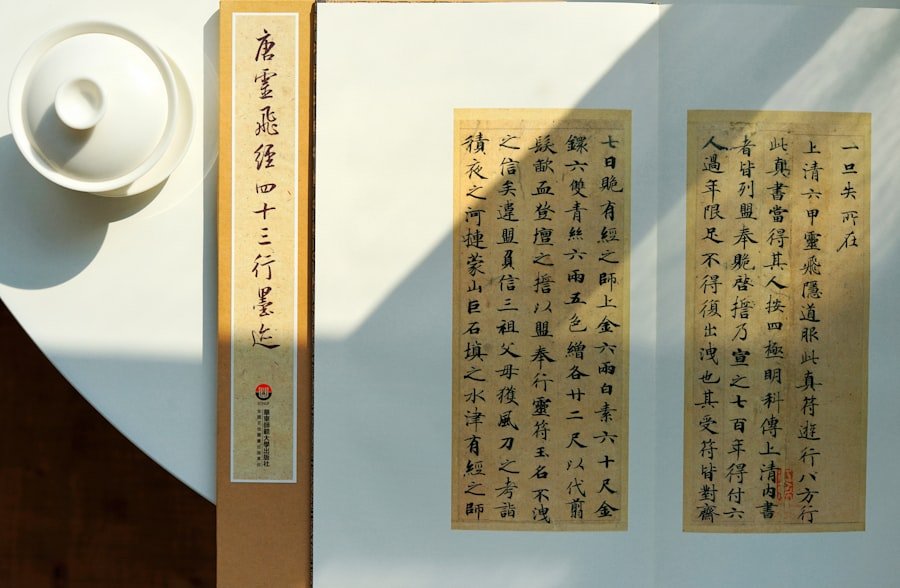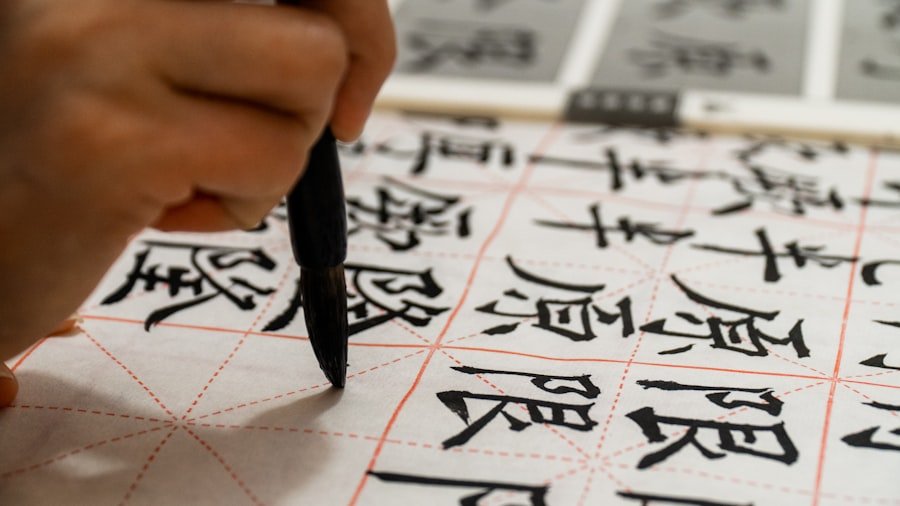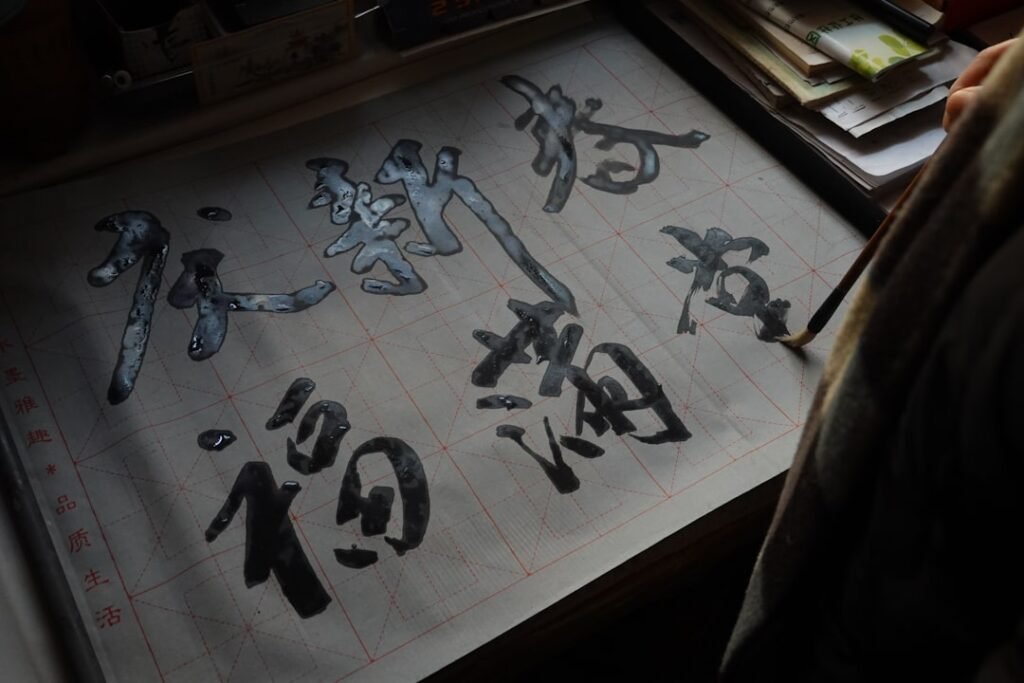Chinese calligraphy, an ancient art form that has flourished for thousands of years, is much more than mere writing; it is a profound expression of culture, philosophy, and aesthetics. Rooted in the rich tapestry of Chinese history, calligraphy embodies the beauty of language through the fluidity of brush strokes and the harmony of composition. Each character is not only a means of communication but also a canvas for artistic expression, where the brush becomes an extension of the artist’s emotions and thoughts.
The practice of calligraphy is steeped in tradition, with its origins tracing back to the Shang Dynasty (c. 1600–1046 BCE), evolving through various styles and techniques that reflect the changing tides of Chinese society. The significance of Chinese calligraphy extends beyond its visual appeal; it is a discipline that cultivates patience, focus, and a deep appreciation for the subtleties of language.
Practitioners often spend years honing their skills, learning to master the delicate balance between structure and spontaneity. The art form is not merely about creating aesthetically pleasing characters; it is also about conveying meaning and emotion through each stroke. As such, Chinese calligraphy serves as a bridge between the past and present, connecting generations through a shared appreciation for this timeless art. Master the art of Chinese calligraphy. Enroll now at the LC Chinese School in Oslo.
Table of Contents
ToggleSummary
- Chinese calligraphy is a traditional art form that has been practiced for thousands of years, using brush and ink to create beautiful and expressive characters.
- Western abstract art has evolved over time, moving away from realistic representation towards more expressive and non-representational forms.
- Chinese calligraphy has spread to the West, influencing artists and becoming a part of Western artistic practices.
- The influence of Chinese calligraphy on Western artists can be seen in their use of brushwork, gesture, and movement in their work.
- Chinese calligraphy has shaped Western artistic techniques and philosophy, continuing to have a significant impact on Western abstract art.
The Evolution of Western Abstract Art
The evolution of Western abstract art marks a significant departure from traditional representational forms, emerging in the early 20th century as artists sought to break free from the constraints of realism. This movement was characterised by a focus on colour, form, and line rather than the depiction of tangible subjects. Pioneers such as Wassily Kandinsky and Piet Mondrian were instrumental in this shift, exploring the emotional and spiritual dimensions of art through abstraction.
Their works challenged viewers to engage with art on a more intuitive level, inviting them to experience feelings and ideas rather than simply recognising familiar images. As abstract art developed, it became increasingly diverse, encompassing a range of styles and philosophies. The movement was influenced by various factors, including technological advancements, cultural shifts, and the aftermath of World War
The Spread of Chinese Calligraphy in the West

The introduction of Chinese calligraphy to Western audiences can be traced back to the 19th century when increased trade and cultural exchange between China and the West began to take shape. As Western artists and intellectuals became more fascinated with Eastern philosophies and aesthetics, they sought to understand and appreciate the intricacies of Chinese calligraphy. Exhibitions showcasing Chinese art, including calligraphy, began to appear in major cities, capturing the attention of art enthusiasts and scholars alike.
In the 20th century, this interest intensified as artists such as Arthur Wesley Dow and John Cage incorporated elements of Chinese calligraphy into their work. Dow’s teachings emphasised the importance of line and composition, drawing parallels between Eastern and Western artistic principles. Meanwhile, Cage’s experimental approach to music and visual art often reflected the spontaneity found in calligraphic practices.
This cross-pollination of ideas not only enriched Western art but also fostered a deeper understanding of Chinese culture and its artistic heritage.
The Influence of Chinese Calligraphy on Western Artists
The influence of Chinese calligraphy on Western artists has been profound, inspiring a myriad of creative expressions that blend Eastern techniques with Western sensibilities. Artists such as Franz Kline and Robert Motherwell drew upon the gestural qualities of calligraphy, incorporating dynamic brushwork into their abstract compositions. Kline’s bold black strokes evoke the fluidity and energy found in traditional calligraphic practices, while Motherwell’s works often reflect a meditative quality reminiscent of Eastern philosophies.
Moreover, the aesthetic principles inherent in Chinese calligraphy have encouraged Western artists to explore new ways of seeing and interpreting their surroundings. The emphasis on spontaneity and intuition in calligraphy resonates with the ethos of Abstract Expressionism, where artists sought to convey their inner emotions through gestural marks. This dialogue between cultures has led to a rich tapestry of artistic innovation that continues to evolve today.
The Aesthetic Principles of Chinese Calligraphy
At the heart of Chinese calligraphy lies a set of aesthetic principles that govern its practice. These principles include balance, rhythm, and harmony, which are essential for creating visually compelling compositions. Calligraphers strive to achieve a sense of equilibrium between positive and negative space, allowing each character to breathe within its context.
This balance is not merely a technical consideration; it reflects a deeper philosophical understanding of the interconnectedness of all things. Rhythm plays a crucial role in calligraphy as well, with each stroke contributing to an overall sense of movement and flow. The artist’s hand must dance across the paper, guided by an intuitive understanding of how each mark interacts with those that precede and follow it.
This rhythmic quality invites viewers to engage with the work on multiple levels, encouraging them to experience the energy and emotion embedded within each character. Ultimately, these aesthetic principles serve as a foundation for both traditional calligraphy and its contemporary interpretations.
The Use of Brushwork in Western Abstract Art

Brushwork is a defining characteristic of both Chinese calligraphy and Western abstract art, serving as a means of expression that transcends language barriers. In Western abstract art, brushwork has evolved into a powerful tool for conveying emotion and movement. Artists such as Jackson Pollock embraced the physicality of paint application, using brushes and other tools to create dynamic compositions that reflect their inner turmoil and spontaneity.
The gestural quality of brushwork in abstract art often mirrors the fluidity found in calligraphic practices. Just as a calligrapher’s brush glides across paper with intention and grace, abstract artists employ similar techniques to evoke feelings and ideas through their work. This shared emphasis on movement allows for a dialogue between cultures, highlighting the universal nature of artistic expression.
The Concept of Gesture and Movement in Chinese Calligraphy
Gesture and movement are central to the practice of Chinese calligraphy, where each stroke is imbued with intention and emotion. The act of writing becomes a meditative process, allowing the artist to connect with their inner self while simultaneously engaging with the physical medium. This emphasis on gesture reflects a broader philosophical understanding within Chinese culture that values spontaneity and authenticity in artistic expression.
In calligraphy, gesture is not merely about the physical act of writing; it encompasses the artist’s emotional state and their relationship with the materials they use. Each stroke carries with it a sense of rhythm and flow that invites viewers to experience the work on an emotional level. This concept resonates deeply with Western artists who have sought to capture similar qualities in their own work, further bridging the gap between Eastern and Western artistic traditions.
The Influence of Chinese Calligraphy on Western Abstract Expressionism
Chinese calligraphy has had a significant impact on the development of Western Abstract Expressionism, particularly in its emphasis on spontaneity and gestural brushwork. Artists such as Willem de Kooning and Mark Rothko drew inspiration from Eastern philosophies that prioritise intuition over rigid structure. The fluidity found in calligraphic practices encouraged these artists to explore new ways of expressing their emotions through abstraction.
The influence of calligraphy can be seen in the dynamic compositions created by Abstract Expressionists who embraced chance and spontaneity as integral components of their work. The act of painting became an extension of their physical movements, echoing the rhythmic qualities inherent in calligraphic writing. This connection between Eastern and Western practices has enriched both traditions, fostering a deeper appreciation for the power of gesture in artistic expression.
The Role of Chinese Calligraphy in Shaping Western Artistic Techniques
The role of Chinese calligraphy in shaping Western artistic techniques cannot be overstated. As artists began to explore Eastern aesthetics, they discovered new approaches to composition, line quality, and brushwork that challenged conventional norms. The integration of these techniques into Western art has led to innovative practices that continue to evolve today.
For instance, many contemporary artists incorporate elements of calligraphy into their work by experimenting with unconventional materials or techniques that reflect the fluidity found in traditional practices. This blending of styles has resulted in a rich dialogue between cultures that encourages artists to push boundaries and explore new possibilities within their creative processes.
The Incorporation of Chinese Calligraphy in Western Artistic Philosophy
The incorporation of Chinese calligraphy into Western artistic philosophy has fostered a greater understanding of the interconnectedness between art, culture, and spirituality. As artists delve into Eastern philosophies that emphasise mindfulness and presence, they begin to recognise the importance of intention behind each mark made on canvas or paper. This shift in perspective encourages artists to approach their work with a sense of reverence for both materials and process.
Furthermore, this philosophical exchange has led to an increased appreciation for the meditative aspects inherent in both calligraphy and abstract art. Artists are now more inclined to view their creative practice as a form of self-exploration rather than merely a means to produce aesthetically pleasing works. This deeper understanding enriches not only individual artistic journeys but also contributes to a broader cultural dialogue that transcends geographical boundaries.
The Ongoing Impact of Chinese Calligraphy on Western Abstract Art
In conclusion, the ongoing impact of Chinese calligraphy on Western abstract art is both profound and multifaceted. As artists continue to draw inspiration from this ancient practice, they find new ways to express their emotions through gesture, movement, and brushwork. The dialogue between Eastern and Western artistic traditions has led to innovative approaches that challenge conventional norms while celebrating cultural diversity.
For those interested in exploring this captivating intersection further, courses at institutions like LC Chinese School in Oslo offer an excellent opportunity to delve into the world of Chinese calligraphy. These courses provide participants with hands-on experience in mastering brush techniques while gaining insight into the rich history and philosophy behind this art form. By engaging with Chinese calligraphy at LC Chinese School, individuals can deepen their appreciation for its aesthetic principles while discovering how it continues to influence contemporary artistic practices across cultures.
Master the art of Chinese calligraphy. Enroll now at the LC Chinese School in Oslo.







